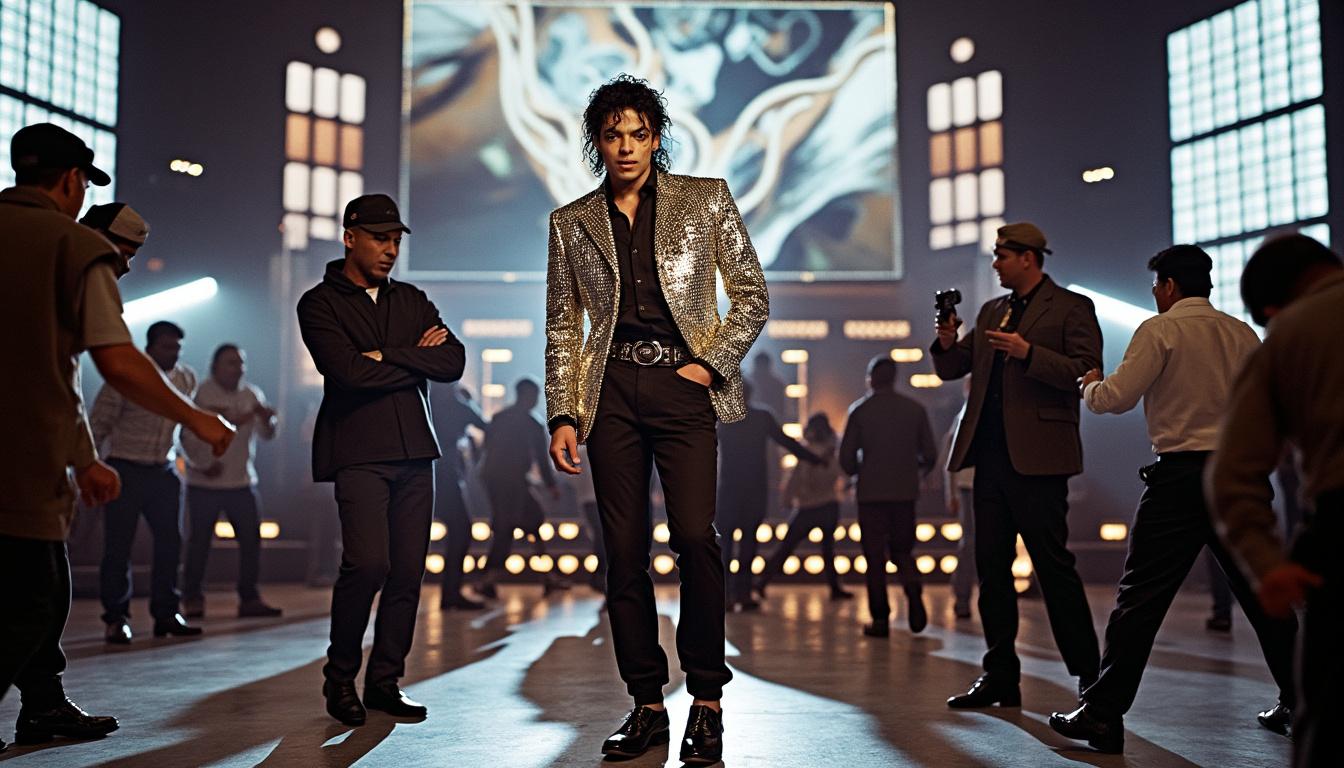The long-anticipated film about the legendary Michael Jackson has recently undergone significant changes, leaving fans buzzing with excitement and uncertainty. As a flagship production poised to delve into the complex life of the King of Pop, this biopic has faced numerous challenges that have impacted its production timeline. Initially slated for a 2025 release, the film has experienced a delay, pushing its theatrical debut to 2026. With a slew of updates surrounding the film’s content and production decisions, the narrative surrounding Michael has transformed into a riveting tale of ambition, setbacks, and possibilities yet to unfold.
Overview of Michael Jackson’s Biopic and Production Turmoil
The biopic titled Michael, directed by acclaimed filmmaker Antoine Fuqua, aims to explore the intricate dynamics of Jackson’s personal and professional life. However, production has not followed a linear path. Reports have surfaced regarding the challenges faced by the team involved, spurred in part by legal complications and creative direction shifts. Central to the film is its lead, Jaafar Jackson, Michael’s real-life nephew, who carries the burden of embodying one of the most discussed figures in pop culture history. The casting also boasts a talented ensemble, including Miles Teller, Colman Domingo, Nia Long, and Kat Graham.
The tumult began when the project encountered assertions tied to discussions of Jackson’s controversial past. Specifically, initial drafts of the script included references to Jackson’s sexual assault allegations from the early ’90s. This angle drew scrutiny due to a pre-existing legal agreement between the Jackson estate and one of Jackson’s accusers, which stipulated that such narratives could not be introduced in film adaptations. As a result, these segments were deemed unusable. This blend of legal constraints with creative storytelling has cast a long shadow over the film’s production, leading to substantial reshoots that were not anticipated.
A key element in understanding the significance of these changes is the film’s third act, which now faces a complete overhaul. Sources close to the production, such as Matthew Belloni from Puck, reported that the film’s new direction will see it conclude after Jackson’s peak in the ’80s, symbolizing a triumph of his career instead of grappling with his tumultuous later years.

The Shift in the Film’s Narrative
Originally set to reflect the complex narrative of Jackson’s life, the film has now adopted a different storytelling technique that focuses on Jackson’s artistry and triumphs rather than the controversies that stemmed from his later years. This pivot indicates a desire to honor Jackson’s legacy through a more controlled lens, possibly to cater to a broader audience who may be sensitive to such narratives.
While the film includes various elements such as Jackson’s meteoric rise, his artistic collaborations, and the cultural impact of his music, many are left wondering about the implications of stripping the film of its more contentious aspects. What does this mean for authenticity in storytelling? For instance, while it may provide a smoother viewing experience, it risks oversimplifying the multifaceted reality of Jackson’s life, which encompassed both unparalleled success and significant personal struggles.
This crossroads reached by the filmmakers indicates that navigating the legacy of a figure like Michael Jackson is a daunting task. Fans and critics alike are eagerly debating the merits of these changes, questioning whether a “sanitized” version of his life can resonate with audiences in a meaningful way. Concerns about potential backlash for ignoring such pivotal aspects remain paramount amidst the ongoing discussions.
- Legal constraints reshaping narrative
- Focus on artistry over controversy
- Dilemma of maintaining authenticity versus broad appeal
Future Sequels in Doubt: Analyzing the Production Gamble
The reshoots and the manner in which the film’s concluding act was changed have also kicked off discussions regarding potential future sequels. Producer Graham King hinted at plans to create a second installment that would revisit the aspects of Jackson’s life cut from the initial film. This continuation hinges heavily on the audience’s reactions and the film’s performance at the box office when it releases on April 24, 2026. The need to evaluate the response from viewers cannot be understated, as it would determine whether the unused footage could be repurposed for a second film or be left on the cutting room floor.
The concept of splitting the final product into two films emerged due to the original cut length of nearly four hours, presenting Lionsgate with a narrative challenge. This decision also ties into the financial implications of the production. If the first film performs well, it could bolster the studio’s confidence in proceeding with plans for sequels. If not, however, they would face the reality of lost investments on the previously shot material. The stakes, thus, could not be higher.
In making such significant creative and logistical decisions, the production team is placing itself in a precarious position, one that encompasses not only the legacy of Michael Jackson but also the future viability of the biopic itself. With the changing landscape of film production, particularly in the face of ever-evolving streaming trends, the confidence associated with traditional box office metrics is diminishing. This uncertainty looms large over the trajectory of the project.
| Production Aspect | Details | Implication |
|---|---|---|
| First Cut Length | Nearly 4 hours | Possible split into two films |
| Reshoot Impact | Changes in narrative focus | Audience reception uncertainty |
| Sequel Possibility | Dependent on first film’s success | Pivotal for tripling audience engagement |
Production Challenges and Reshoots: The Chaotic Landscape
The journey toward completing the Michael Jackson biopic has not been without its fair share of challenges. Production turmoil often accompanies high-profile films, but the unique circumstances surrounding this one have generated considerable media attention. The combination of legal constraints and creative reinterpretations created a chaotic environment for filmmakers seeking to fulfill their artistic vision.
Amid the backdrop of these complications, reports indicate that the production team has engaged in considerable reshoots of the film’s entire third act, in alignment with evolving narrative guidelines. As mentioned, these reshoots come in response to a stringent legal agreement that circumscribed which aspects of Jackson’s life could be shown, ultimately leading to significant portions of filming deemed unusable.
The intensity of production challenges is reflected not only in the myriad logistical issues faced by the team but also in the urgent need to balance the demands of filmmaking with public perception. As news outlets cover ongoing developments, any misstep can lead to public relations fallout, potentially exacerbating tensions with both the Jackson estate and longtime fans. Managing these relations thoughtfully has become integral to the overall film strategy.
- Legal constraints impacting filming
- Urgent reshooting of the third act
- Balancing artistic vision and public perception
Implications of the Shift for the Legacy of Michael Jackson
The ramifications of alterations to the film extend beyond mere logistics and storytelling; they delve into the broader implications for Michael Jackson’s legacy. Jackson remains a complex figure whose life and art continue to inspire fierce debate. The decision to alter the narrative arc risks reshaping public discourse around not only the film project but also how Jackson as an artist will continue to be perceived in the cultural lexicon.
While the intention behind such changes may be to safeguard and celebrate Jackson’s artistic achievements, it also begs the question of whether the multifaceted realities of his life can truly be captured without addressing the more controversial elements. The fact that ingredients for a complete narrative have been omitted may inadvertently skew public perception by minimizing aspects of his life that were defining, albeit tragic.
In examining how films can shape and influence cultural legacies, the departure from presenting a full spectrum may lead to a kind of historical revisionism, where complex narratives become simplified into palatable, digestible formats. The challenge lies in the filmmakers’ ability to navigate this path without losing the essence of the very figure they seek to portray.
| Element | Previous Inclusion | Rationale for Exclusion |
|---|---|---|
| Sexual Abuse Allegations | Discussion in the narrative | Legal agreement preventing exploration |
| Later Career Controversies | Part of the story arc | Focused on celebratory achievements instead |
| Accuser’s Perspective | Potentially included | Avoiding additional legal implications |


